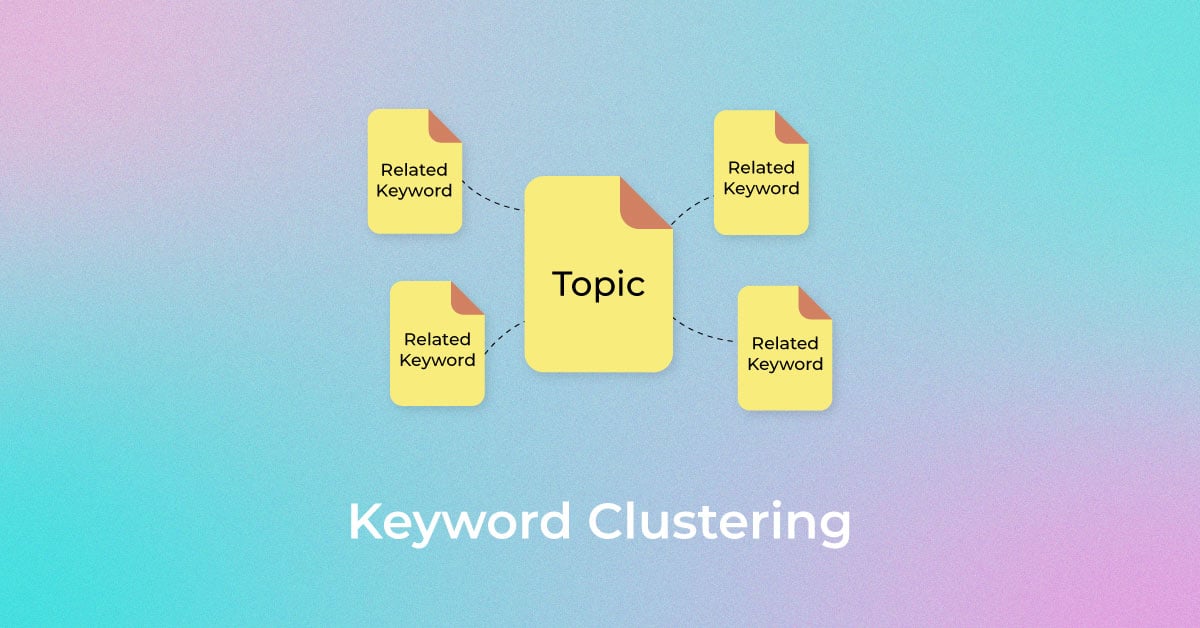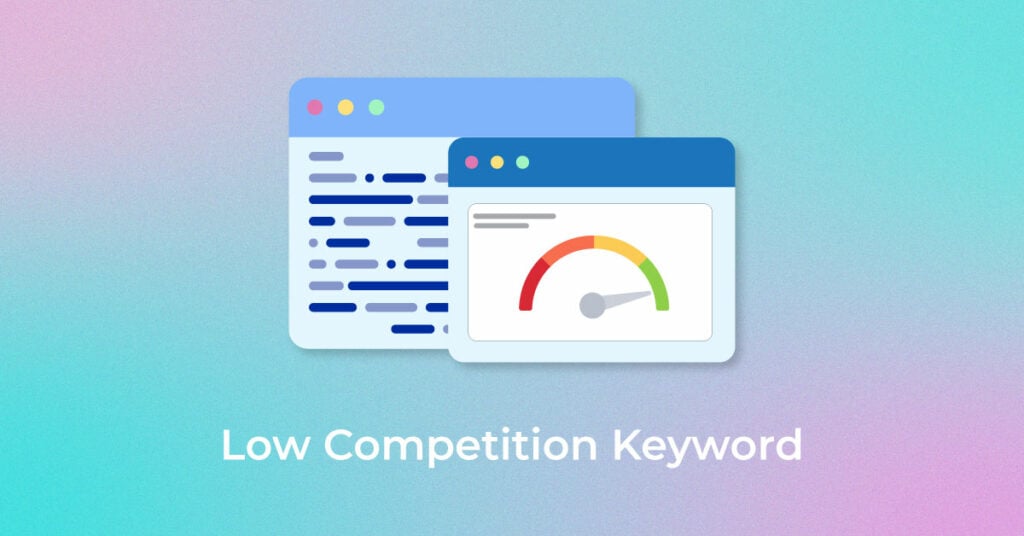Every domain, new or old, wants to rank for the really competitive keywords. This would mean gaining an unbelievable amount of traffic on your site. But, of course, in reality, this is not easy to achieve. Unless you are using a domain with a very high domain ranking, it will be nigh on impossible to overtake the giants that dominate each sector. So, if your domain is new and has next to no authority, reaching the top of the search results will be difficult if not unachievable.
But if targeting high-competition and high search volume keywords is not a good idea, especially if you want to gain traffic and exposure in a short span of time, then what exactly should you be building your content around? The answer lies in low-competition keywords.
However, before we delve into how that works, we must first learn what low-competition keywords actually are.
What are low-competition keywords?
Simply put, low-competition keywords are search queries which very few brands and businesses compete for as part of their search engine optimization and ranking efforts. Since they have very few domains competing for them, it is easy to rank for them. This makes them the perfect choice for digital marketers looking to generate traffic on their clients’ sites in a short span of time.
Low-competition keywords are especially perfect for domains that are comparatively new to the arena and have next to no domain authority as a result. Usually, it can take up to six to eight months before we see the results of their search engine optimization efforts. But low-competition keywords being rather easy to rank for, can drive traffic to your client’s site without you having to spend time and money building backlinks, generating relevant content and getting brand mentions.
Why are low-competition keywords important in SEO?
There is a reason low-competition and high search volume keywords are referred to as Holy Grail SEO. Low-competition keywords are the low-hanging fruit in digital marketing. They will amp up your client’s domain rank and generate traffic from organic searches in a very short period of time.
This makes these keywords especially effective for websites that haven’t been around for that long and haven’t had time to build their authority or credibility. They give these low-authority sites a fighting chance. Of course, it also depends on your ability to hit that sweet spot between low competition and high search volume.
These keywords come especially handy if you are working on optimizing a site that:
- Has no or low authority and popularity
- Is completely or relatively new
- Is trying to rank in a very competitive industry
When done right, something as simple as a blog that targets low-competition keywords can give you some much-needed exposure. The goal should be to find more high-volume keywords during your research with low keyword difficulty scores. These are the low-competition keywords that will bring the best results for your website, and finding them is quite hard, especially in competitive domains.
In such cases, low search volume keywords are a great alternative too. Trying to rank for low-volume keywords may seem counterintuitive because of the notion that they are low in value, but that is not necessarily the case here. The SEO results can still be positive if you create content using low search volume and low competition keywords.
Long-tail, low-search volume keywords offer you relevance, i.e., let you focus on your target audience and offer them specific information. They also help you build exposure around unique niches. They are low competition, so you can easily rank for them without battling your competitors. They also help you rank for a greater range of keywords, diversifying your strategy and bringing in a wider audience.
Such keywords are also likely to offer easily convertible leads. When you target keywords with variations of “buy,” for example, it can directly lead you to people actually looking to make a purchase. The traffic you glean from this may not be high, but is likely to comprise leads who actually want to convert. And while one low-competition keyword may also have a low search volume, when several of them are used together smartly, their reach adds up, effectively giving you access to a much wider audience.
Difference between low-competition keywords vs. high-competition keywords
To understand the difference between high-competition and low-competition keywords, you must first know what keyword competition is and how exactly it works. Keyword competition is used to measure the level of difficulty involved when one is trying to rank for a particular keyword. Several factors, including the popularity of the said keyword and the competitiveness of the industry, come into play when determining how competitive a keyword is.
High-competition keywords are, to put it simply, keywords that are difficult to rank for given their popularity. They almost always see high search volume and will consequently be sought after by most of your competitors. Despite the high search volume, it is difficult to get traffic to your domain using these keywords. This is especially true for sites that are (relatively) new and have little to no domain authority. It can take months, even years, to get results from your SEO campaigns if you only focus your efforts on these kinds of keywords.
On the other hand, low-competition keywords may see low or high search volume. But either can be effective in driving traffic to your site, especially when you target keywords to your specific niche. As previously mentioned, the traffic generated from using a combination of low-competition and low search volume keywords can add up and bring you easily convertible leads.
So, who should go for low-competition vs. high-competition keywords?
Sometimes, no matter how up-to-date your site is and how much effort you spend establishing backlinks, creating great graphics, and producing relevant content, you just can’t outrank other domains. This is usually because the domains in question have a higher authority or domain ranking compared to yours. These rankings are measured from 0 to 100. The higher the value of your ranking, the greater the chances of your site appearing at the top of the search results. This means that established juggernauts in the business — like Forbes, Hubspot, and Semrush — will easily rank for keywords and topics seemingly without putting half the effort you do into your site.
So, competing against these giants — whether they are specific to your industry or produce general content — can be close to impossible. In such cases, the best idea would be to aim for low-competition keywords. If these keywords also have a high search volume, then you have just been handed the Holy Grail. If not, don’t despair. Even using low search volume keywords can be more effective for your SEO campaign than competing against giants by aiming for keywords they are targeting. This is especially true if you want to see definite results in the form of easily convertible traffic in the short term.
To sum up, if your domain is new, doesn’t have much in the name of domain authority, and needs to see results in the span of a few months, you should aim for low-competition keywords.
How to look for low-competition keywords?
Now that we have established the importance of low-competition keywords, we need to know how to go about actually finding them. Here are some tried and tested methods you can use to find great low-competition keywords to design your content and focus your SEO strategy around:
1. Brainstorm topics
Begin by brainstorming topics. Get the team together and come up with topics that you know your target users may look up. No need to spend too much time or effort on this; coming up with a few broad ideas related to your industry and your own business should be enough. For example, if you sell custom car parts, then listing down terms like cars, car parts, custom car, car parts, custom engine, etc., should be enough. If you are stuck, try Googling similar businesses and look for ideas there. Once you have made a list of 10-20 topics, you should have enough to go on.
2. Keyword tools
Once you have a list of generic themes and topics, you can now make use of keyword tools to come up with keywords you can focus on. You can use the most popular keyword tools here. Ahrefs Keyword Explorer is definitely a popular option but you can go ahead and plug your generic topic ideas into the tool of your choice. The tool should immediately show you the related keywords for that topic. It will also show you the keyword metrics, like monthly search volume, global popularity, etc. The keyword tool of your choice should also show you the keyword difficulty (or a variation of the same). This metric basically specifies how difficult it would be to rank for those specific keywords.
Now you need to go ahead and set the filter to show you low-difficulty or low-competition keywords specifically. In the case of Ahrefs, this will involve filtering for keywords with KD from 0-10 in the Phrase Match report. You should find hundreds and thousands of prospective keywords this way. You can further narrow down that list by filtering for, say, a minimum monthly search volume.
3. Google search bar
While it may sound too easy to be real, you can actually just use Google’s search bar to find all the low-competition keywords you need. Begin by going back to the generic topic list you came up with earlier and putting them in the search bar. Google should offer to fill in the blanks.
Let’s go back to the custom car parts example. If you search for a phrase like “where custom car parts…”, Google will offer up a host of ideas. Click on a suggestion that seems relevant, like “Where to buy custom car parts” and see if there are any giant domains that are trying to rank for it. Forums and such are okay since they don’t focus efforts on specifically ranking a particular thread. If there are no sites with higher domain rankings offering up the exact answer to the query you looked up, you can directly produce a blog specifically around that keyword, and you will find yourself ranking for it in no time.
4. People Also Ask
Speaking of making use of the Google search bar, another great tool to use is the People Also Ask section. But what exactly is the People Also Ask section, and how does it work?
PAA or People Also Ask is a SERP section of Google that offers you insight into what queries people are generally looking up. Note that these are all questions related to the original query you plugged in, which pretty much makes this section a gold mine for finding exactly which queries you can target to lead traffic to your site. Each question usually is followed by a short note or answer to that query. It will also include a link to a webpage that will offer a more detailed answer. All of these answers come in a range of media formats and may just be snippets of text, videos, tables of data, and so on. What makes this section important, especially for your SEO needs?
The main motive behind the section is to provide users answers to queries related to their original question. This can give them additional details about the subject and help direct them if they don’t know where to look. For digital marketers and SEO managers, this section lists all the topics they can use as keywords. One can take the questions and directly base entire blogs around them. Of course, you can also use them as subsection headings. If you use the section and queries smartly, Google may pick up your blog and feature it in the PAA section, thus, bringing your domain additional exposure. And how exactly can you achieve this? Here are some things to keep in mind when you want to be featured in the PAA section:
- Use more lists: We don’t mean that you should force lists in places where there is no need for one, but try to replace tables with more lists. Google usually struggles with table formats in both People Also Ask and Featured Snippets sections. This makes it more likely to feature answers with lists — numbered or otherwise — in its PAA and featured snippets sections.
- Answer the query without beating about the bush: The best practice, in this case, would be to answer the question head-on at the beginning of your blog or sub-section. Keep it short, simple, and to the point. Basically, imagine what a PAA snippet usually looks like and design the content accordingly. You can, of course, delve deeper into the query in the latter part of your blog or sub-section.
- Turn queries into subheads: Turning queries into subheadings doesn’t just help users find what they are looking for. It also helps Google and other search engines to pinpoint exactly what the section is about, exponentially increasing the chance of the section being featured in the PAA.
- Make sure the images are optimized: Add captions, alt-texts, and surrounding text to describe the image, so Google knows exactly what it is looking at.
The PAA section, thus, comes in handy in not just finding the low-competition keywords but also helping you leverage the same to bring more traffic to your site.
5. Get More Suggestions At The End of SERP
You can get a lot of low-competition keyword suggestions by using SERPs. Just type in your primary query and watch Google come up with related long-tail queries. However, you need to play around a bit before you can find the perfect mix of long-tail keywords with adequate search volume and relevance to your brand.
Is it easy to find low-competition keywords?
There is no way to directly answer this question since more than one factor comes into play here. Google has never revealed what methods it uses to rank results. This makes all the expert answers on the internet mere speculation. This is why different keyword tools out there use completely different methods to judge keyword difficulty. For example, Ahrefs’ keyword tool focuses on backlinking to measure keyword difficulty. It calculates how much effort one needs to put into building backlinks to rank for a keyword and bases its difficulty score on that. But backlinking, while essential to any SEO strategy, is not the only influencing factor. There’s also:
Domain authority
Even if the keyword sees low levels of competition, brands with greater domain authority are still more likely to rank for it. While Google has publicly dismissed the idea of that being true, it is still true that if your site has low authority, it may struggle to rank for even low-competition keywords. This makes it important to try and rank for long-tailed keywords that are more relevant to your business. It can further reduce your stress of going up against giants to rank for keywords they might be using, and most likely, paying for as well.
Search intent
Low-competition keywords may be easy to rank for, but you still need to design your content to actually target the query. Basically, keep the user’s search intent in mind while designing content around a specific keyword. If you are trying to rank for transactional, i.e., purchase-centric, keywords, try to create content that actually includes information on where the user may make the purchase.
The quality of backlinks
The number of backlinks isn’t the only important factor. The quality of your backlinks matters too. Keyword tools won’t be able to take every quality-related metric into account while deciding the level of keyword difficulty. So, it is essential to put time and effort into manually delving deeper into the quality of the backlinks by checking their relevance, authority, placement, etc.
Should you avoid high-competition keywords?
So far we have more than established just how difficult it is to rank for high-competition keywords. Does that mean you should entirely avoid high-competition keywords because there is almost no way to rank for them?
Turns out, using high-competition keywords as part of your strategy has its benefits.
You can use them to create what’s referred to as link bait. Basically, take high-competition queries and create blogs around them. You can then reach out to high-authority websites and ask them for backlinks. Even if your domain has low authority, if your content is good enough and targets a query with high search volume, you can gain backlinks.
You can also use this method to build domain authority in the long run. Even if you cannot rank for these keywords now, building domain authority can help your business gain exposure and traffic in the long run. Moreover, if you are successful in your link-baiting efforts, you can backlink to and pass on the SEO juice to important but “boring” pages that are difficult to get backlinks for.
Start Paying Attention to Low-Competition Keywords
Low-competition keywords can act as the low-hanging fruit or the Holy Grail of SEO for websites. In a perfect world, low-competition keywords would also come with high search volume. But since that’s hardly possible, low search volume keywords, when used smartly, can bring in much-needed exposure in the span of a few months. Infidigit is an SEO company that specializes in researching and effectively implementing low-competition keywords for businesses. Are you looking to refine your SEO and realize the true potential of low-competition keywords? Contact us today to learn more.
Popular Searches
How useful was this post?
0 / 5. 0

















